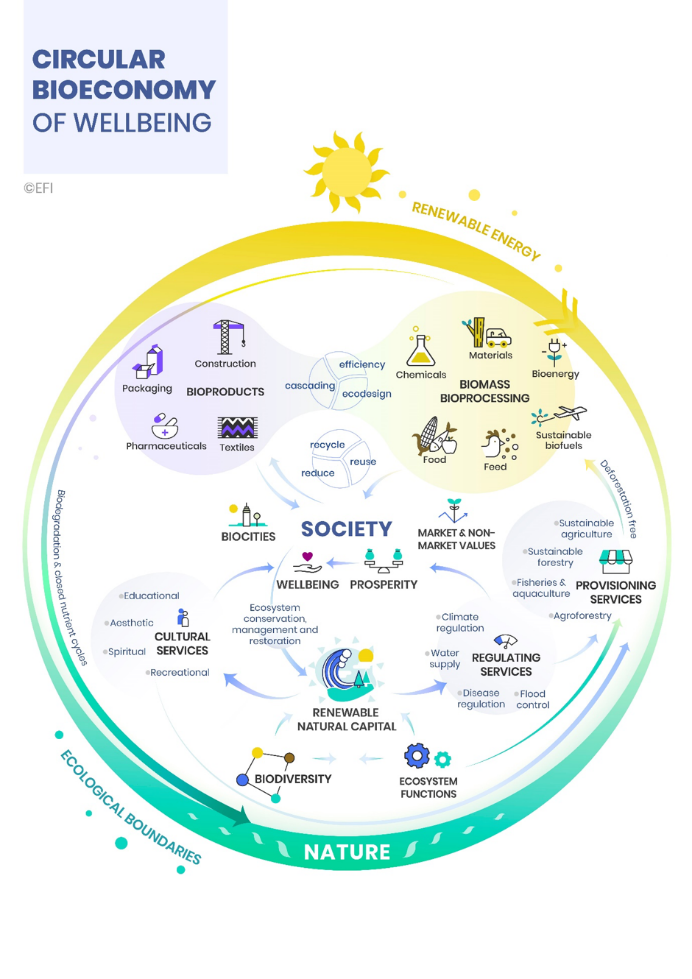Professor Jacqueline McGlade
The oldest business model in the world is the circular bioeconomy. Nothing wasted, everything used and reused, with Nature as the powerhouse. A growing number of the world’s top CEOs, investors, political leaders and researchers consider it to be the blueprint for the post-COVID recovery.
Back in the 1970s, ideas of modernity were inextricably linked to fossil fuels. New affordable vehicles, global aviation, amazing branded packaging, plastics everywhere, new textiles, and construction. It was all about the versatility of oil and our growing addiction. But the consequences of endless burning and processing of fossil fuels, is a world filled with pollution that is harmful to both people and planet.
The circular bioeconomy draws on nature-based solutions to our everyday needs. It is about expanding the range of innovative products using agro-forestry-marine processes, opening up consumer markets with biobased solutions to create local industries and improve livelihoods everywhere. The circular bioeconomy has the potential to solve the multiple challenges of encouraging local investment, generating prosperity by creating decent jobs and improving health, education and food security whilst protecting ecosystem services such as clean water, biodiversity and cultural heritage. So how does it work and how quickly can it happen?
First, we must change the ways in which we use our forests. They can be much more than a source of certified timber and carbon sequestration. They are also a store-cupboard and reservoir of raw resources and services for a vast array of new and innovative construction, energy, packaging and textile products. Timber companies, formerly tied to producing just timber, pulp and paper, can now produce renewable and sustainable biofuels to help replace fossil fuel raw materials and reduce carbon emissions, packaging and self-adhesive materials, biocomposites and high-performance products for construction, revolutionary fillers for lightweight electrical insulation, different kinds of bioplastics, nanofibrilar cellulose hydrogel for 3D cell culturing to support human cells and tissues implants a vast array of textiles. We can now plan for a future where affordable and rapid housing development comes in the form of beautiful wood-composite modular homes, reducing the need for multiple container loads and noise from construction sites, of multi-storey buildings up to 20 floors that are light enough to be built over tunnel areas in inner cities, and floating houses that can draw their energy from the water itself. These new wood cross-laminates are strong and light, produce half the emissions of concrete and steel, store carbon for their lifetime and at the end-of-life can be used for energy or recycled. And all of this comes with greater biodiversity, increases in the benefits of ecosystems services including air and water filtration and carbon storage at the core. All it takes is one sunny day of forest growth to build and power the homes of our future.
Second, there need to be improvements in agriculture and fisheries and support for the uptake of agroecology. This can help restore and maintain soil health, increase yields while reducing input costs and levels of pollution, produce more nutritious foods and supply the feeder stocks organic waste for the industrial production of bioplastics and lubricants. In the same way, a more integrated value chain approach to fisheries can help create to new local industries, such as using the waste from fish processing to make bioplastics and other forms of packaging.

Flows in the circular bioeconomy of wellbeing. Source: Palahí et al. Solutions 11(2) June 2020.
In a warming world, where greenhouse gas emissions need to be reduced and carbon stored, at the same time as ensuring everyone’s needs for food, housing, clothing and energy, it makes social and business sense to invest in a circular bioeconomy. What is needed now are well-devised policies that link land and marine stewardship to well-articulated biobased value chains, innovative product design and regulations and clear consumer advice. These measures will ensure a new generation of agri-forest-marine biobased industries and value chains is created which will help transform the future of local communities for the better.
The potency of the circular bioeconomy as a way of investing in nature to transform the post-COVID economy is gaining traction. It involves new economic thinking about the four capitals - natural, social, human and produced – that we depend upon. It looks to transformative policies, purposeful innovation, access to finance and risk-taking capacities, as well as sustainable business models and markets based on valuing nature.
Planting millions of trees, regenerating the health of our land, establishing innovative biobased product technologies – all core elements of the circular bioeconomy - will not only help us achieve net zero-carbon emissions more quickly, but ensure the livelihoods of millions and local community prosperity in the face of climate change.
Professor Jacqueline McGlade is Professor of Environment and Sustainable Development at the Institute for Global Prosperity (IGP) and lead scientist for PROCOL Kenya. She tweets @jacquiemcglade
Image credit: Marc Schulte on Unsplash
Fatemeh Sadeghi
30 May 2024 Feminists in the Global South have stepped out of the conventional territories of ‘women’s matters’ into more fund...